2010 F150 Blower Motor Resistor Bad Again
Blower motor, resistor: how it works, symptoms, problems, testing
Updated: August 01, 2021
The motor that runs the fan in the heating and air-conditioning system in a car is chosen a blower motor. It'south located inside the dash, oft on the opposite side of the steering bike or within the engine compartment on the firewall. A blower motor resistor or a blower motor control module is the part that controls the speed of the blower motor.
What is the difference? A blower motor resistor is a uncomplicated electric resistor. Information technology'southward used in cars where the blower motor has only four or v fixed speeds, as on the left side in this diagram. See the photo of the Ford blower motor resistor.
Cars with an automatic climate control system and vehicles where the blower speed can be adjusted gradually are equipped with an electronic blower motor control module, come across the photo.
In almost modernistic cars, the blower motor resistor or the command module are installed inside 1 of the ducts in the HVAC system, close to the blower motor. This is done, so the resistor or a control module is cooled downwards by passing air. In some older cars, a blower motor resistor was installed on the firewall with admission from under the hood.
Blower motor resistor / control module bug
Problems with a blower motor resistor are common in many cars. The near common symptom of a failed blower motor resistor is when the heater fan simply runs at the highest speed setting (4 or v) and doesn't work at low speeds. In some cars, a failed blower motor resistor tin can cause a heater fan to stop working completely.
In virtually cases, a blower motor resistor fails due to corrosion or overheating. Sometimes, the mechanical resistance to the motor rotation causes an excessive electrical electric current that can overheat and prematurely harm the blower motor resistor. For example, this happens when the fan blade is jammed by a foreign object or when the motor bearings are worn out and it doesn't spin freely.
Problems with a blower motor command module are less frequent, but it fails for the same reason: due to corrosion or overheating when the motor is jammed or shorted. In nearly cases when a blower command module fails, the blower motor doesn't piece of work at all. In some cars (e.g., older GM trucks), a failed blower command module or processor tin can crusade the blower motor to continue running fifty-fifty with the ignition OFF.
How is the blower motor resistor diagnosed?
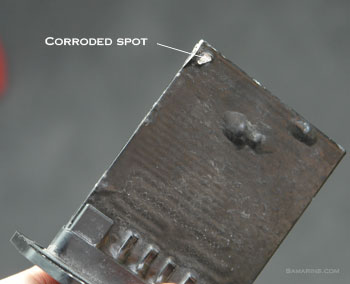 This Ford blower motor resistor has failed due to corrosion
This Ford blower motor resistor has failed due to corrosion
Diagnostic procedures vary. Oftentimes a visual inspection of the resistor reveals the problem. For instance, as you tin can see in this photo, the blower motor resistor in this Ford Escape has failed due to corrosion.
If the resistor shows no visual damage, the resistance between terminals must be checked and compared to specifications. If the resistance is out of specs, the resistor must be replaced.
For example, in this photo we measured the resistance of this blower motor resistor. According to the service manual, it must be around iv-5 ohms.
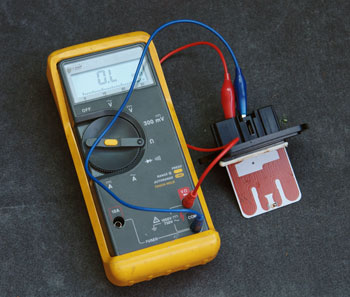 Failed resistor tested with an ohm-meter
Failed resistor tested with an ohm-meter
In our instance the ohmmeter shows open up circuit, which means the resistor has failed.
Sometimes, a blower motor resistor might neglect due to problems with the blower motor itself. This means afterward replacing the blower motor resistor, check if the blower motor runs freely and doesn't brand any noise. We have seen instances where a worn-out blower motor causes a recently replaced resistor to neglect again. For case, this result was common in older Chrysler and Dodge minivans. In this case, the blower motor must also be replaced. One of the symptoms of a worn out blower motor is that it can intermittently produce a loud screeching racket when running.
How to exam the blower motor?
If the blower motor doesn't piece of work at all, the blower motor itself must exist tested showtime. Typically it's done by measuring the voltage at the blower motor connector when information technology's turned on. If at that place is a voltage at the motor (at least 4-6 Volt at low speed and 12 Volt at high speed), but the motor doesn't run, the motor is bad or jammed.
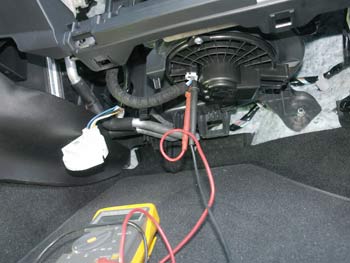 Testing the voltage at the blower motor. If there is a voltage at the motor (at least 4-6 Volt at low speed and 12 Volt at loftier speed), but the motor doesn't run, the motor is bad.
Testing the voltage at the blower motor. If there is a voltage at the motor (at least 4-6 Volt at low speed and 12 Volt at loftier speed), but the motor doesn't run, the motor is bad.
Things like leaves, twigs, nuts, pieces of a ripped motel filter can jam the blade of the blower motor. This happens often in many cars.
If there is no voltage at the motor, the entire blower motor circuit must be tested, starting from a fuse. See: how to check a fuse in a car.
If a blower motor is bad, it will demand to exist replaced. The blower motor replacement costs from $320 to $650, depending on the auto. In many cars it's fairly like shooting fish in a barrel; the blower motor is located behind the glove box and held past three-4 screws. In others it might be located inside the dash (e.g. Mazda 5) which makes replacement difficult.
If you need a proper diagnostic procedure, we accept posted several links where you can access a service manual for your automobile for a subscription fee. Check this mail, scroll downwards the page.
How is the blower motor command module tested?
Mechanics at a dealership can diagnose the HVAC system with a scan tool. If the scan tool is not bachelor, in many cars with an automated climate control system there is a cocky-testing or diagnostic manner.
Typically it tin be activated past pressing and holding unlike buttons. For example, in the 2009 Honda Accord, the service manual describes the procedure as follows: Plow the ignition to ON. Press and concord the OFF button and within ten seconds press and release the Window Defogger push 5 times. The arrangement enters the self-diagnostic mode and at the end of it, if there is a trouble, the fault code will exist displayed on the display. The service manual describes the testing process for each code. Encounter, for case, these YouTube videos; add make and model of your vehicle.
Some other fashion is to bank check the voltage at the blower motor, the blower motor control module and other parts of the circuit co-ordinate to the service manual. For example, in the mentioned 2009 Honda Accord, the + 12V power is supplied directly to the blower motor through the fuse and and so through the relay.
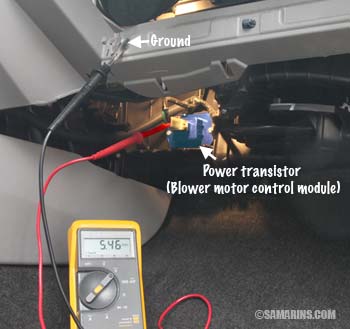 Testing Honda power transistor (blower motor control module).
Testing Honda power transistor (blower motor control module).
The blower motor control module (Honda calls it Power Transistor) supplies the footing. The power transistor has 4 wires: two come from the climate command organization control unit of measurement, one is the ground, 1 goes to the negative concluding of the blower motor. The service manual advises measuring the voltage at the blower motor, then if not OK, at the power transistor and so on.
A failed ability transistor was a fairly common crusade for non working blower motor in some Honda and Acura vehicles. For case, the Honda message 03-048 described a problem where the blower motor for the rear HVAC system in the 2003 Airplane pilot would not work at all speeds.
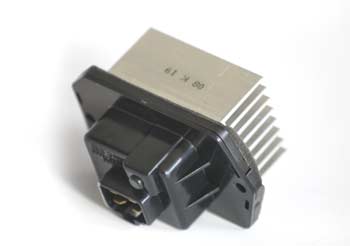 Honda blower motor control module (power transistor)
Honda blower motor control module (power transistor)
The message recommends replacing the rear power transistor equally a solution.
BMW calls the blower motor control module a Final Stage Unit of measurement, which is also fairly common to fail. Sometimes it doesn't neglect completely, but causes the blower motor to finish working intermittently or run at various speeds. See these YouTube videos for more than info.
In some GM trucks, a blower motor control module failure can cause the front blower motor to stop working or run after the vehicle has been close off. The GM bulletin 06-01-39-002C describes this trouble that happens in cold weather. The message advises replacing the blower motor control module. GM calls it Linear Ability Module (LPM). Lookout man these YouTube videos for more info.
Repair options
Your local mechanic or any small repair store should be able to diagnose the trouble. Of course, the quickest manner is to make an appointment with your dealer. Many dealers have the role in stock. The blower motor resistor or control module replacement is not very expensive.
For example, one of our colleagues had a problem with his 2011 Ford Escape: the fan simply worked at the speed iv. He paid $50 to diagnose and $112 to replace the resistor at a local Ford dealership. When the aforementioned trouble occurred ii years later, he ordered the office online for $25 and replaced information technology himself.
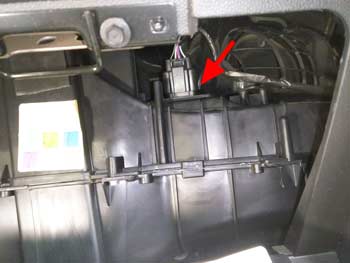 In the 2008-2011 Ford Escape / Mazda Tribute, the blower motor resistor is located on superlative of the HVAC unit, backside the glove box.
In the 2008-2011 Ford Escape / Mazda Tribute, the blower motor resistor is located on superlative of the HVAC unit, backside the glove box.
In the 2008-2011 Ford Escape, the resistor is located behind the glove box on peak of the HVAC unit air duct. It's held past two screws and is easy to supercede. See the photograph.
In the 2008-2011 Ford F150, the blower motor resistor is also located behind the glove box, only is installed on the right side of the plastic air duct. This thread at f150online.com shows where the resistor is located.
The author of this blog shared his experience of replacing the blower motor resistor in Jeep Liberty. In some older cars and trucks, the blower motor resistor is installed on the firewall, with admission from under the hood.
How the blower motor resistor works
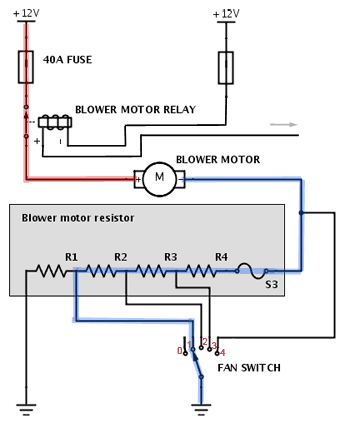 Typical blower resistor diagram
Typical blower resistor diagram
This diagram shows how the blower motor resistor is connected in a typical car. In this automobile, in the highest "4" fan speed setting, the resistor is bypassed and the blower motor is powered directly by the fan switch. That'due south why in some cars, the blower motor may notwithstanding work in the "High" speed setting if the resistor is bad.
In this diagram, the fan switch is set to the speed "ane", so the blower motor current is reduced by iii resistors (R2 + R3 + R4) continued in series. The current catamenia is shown in blue and cerise.
In the setting "two", there are two resistors continued in series, and in "three", there is simply one resistor.
Adding resistance to the electric circuit reduces the current in the excursion. When several resistors are connected in series, the total resistance increases and is equal to the sum of private resistances.
Source: https://www.samarins.com/glossary/blower-motor-resistor.html
0 Response to "2010 F150 Blower Motor Resistor Bad Again"
Post a Comment